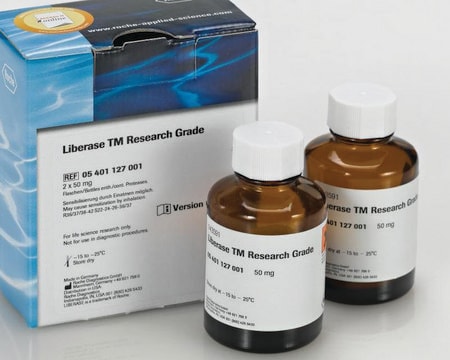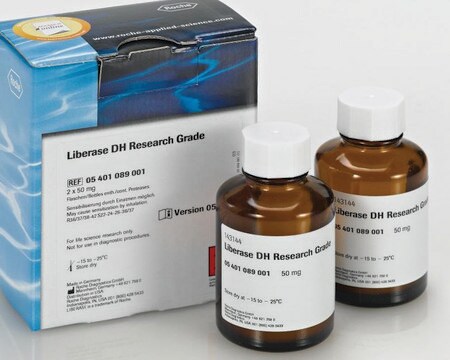LIBTH-RO
Roche
Liberase™ TH Research Grade
lyophilized, suitable for tissue processing, optimum pH 7.4
About This Item
Produtos recomendados
fonte biológica
Bacillus polymyxa (dispase)
Bacillus sp. (thermolysin - Bacillus thermoproteolyticus)
Clostridium histolyticum (collagenase)
Nível de qualidade
descrição
high Thermolysin concentration
forma
lyophilized
embalagem
pkg of 10 mg (05401135001 [2 x 5 mg])
pkg of 100 mg (05401151001 [2 x 50 mg])
fabricante/nome comercial
Roche
Parâmetros
35-37 °C optimum reaction temp.
técnica(s)
tissue processing: suitable
pH ideal
7.4
temperatura de armazenamento
−20°C
Categorias relacionadas
Descrição geral
Aplicação
Características e benefícios
- Maximize viability and yield of isolated cells
- Count on higher specific activity of the enzyme blend
- Obtain higher experimental reproducibility
- Increase safety
Nota de preparo
Working concentration: Liberase Research Grade Enzyme Working Concentration:
Liberase enzymes have significantly higher specific activities than traditional collagenases. This means that the working concentration of Liberase Research Grade Purified Enzymes, expressed in mg/ml, will be lower than that of traditional collagenase.
When the application is on the Roche list of applications at www.collagenase.com, use the Liberase Research Grade concentration recommended for that application.
When the application is not included on this list, first use Liberase TM Research Grade at a concentration of 0.08–0.28 Wünsch units/ml.
The goal is to determine the best starting concentration of Liberase Research Grade Enzyme Blends. This is a starting point, and the final concentration may vary due to differences in procedure and lot-to-lot differences in traditional collagenase.
Collagenase Working Concentration:
Multiply your previous collagenase working concentration (mg/ml) by its specific activity (Wünsch units/mg, [as determined above]), to obtain Wünsch units/ml. To determine how much Liberase Research Grade Enzyme Blend to use, first multiply your collagenase working concentration (in Wünsch units/ml) times the total volume of your working enzyme solution to obtain the total collagenase activity needed (Wünsch units). Divide the total collagenase activity required by the Liberase Research Grade stock concentration ( “Reconstitution and Storage”). This indicates how many milliliters of Liberase Research Grade Enzyme Blend stock solution to use in your working enzyme solution.
Storage conditions (working solution): Store unused stock solution in single-use aliquots at -15 to -25 °C. For further information on product stability please visit the Roche Liberase Enzyme website at www.collagenase.com.
Note: Avoid repeated freezing and thawing!
Reconstituição
Reconstitute the entire vial. Do not weigh individual aliquots of the lyophilizate. The introduction of moisture into the vial results in a decline in enzymatic activity.
Place vial on ice to rehydrate the lyophilized enzyme.
Gently agitate the vial at 2 to 8 °C until enzyme is completely dissolved (max. 30 min).
Depending on the type of tissue-dissociation buffer used to dissolve Liberase Research Grade Purified Enzyme Blends, slight precipitations may be observed which readily dissolve in the diluted working solution and have no influence on enzyme activity.
Remove an aliquot of the stock solution to prepare the working solution.
Reconstitution volume
2 ml (1 vial with 5 mg–10 mg pack size), 10 ml (1 vial with 50 mg–100 mg pack size)
Collagenase Wünsch (units/ml)
13 (1 vial with 5 mg–10 mg pack size), 26 (1 vial with 50 mg–100 mg pack size)
Total Collagenase concentration [mg/ml]
2.5 (1 vial with 5 mg–10 mg pack size), 5.0 (1 vial with 50 mg–100 mg pack size)
Outras notas
Informações legais
Palavra indicadora
Danger
Frases de perigo
Declarações de precaução
Classificações de perigo
Eye Irrit. 2 - Resp. Sens. 1 - Skin Irrit. 2 - STOT SE 3
Órgãos-alvo
Respiratory system
Código de classe de armazenamento
11 - Combustible Solids
Classe de risco de água (WGK)
WGK 1
Ponto de fulgor (°F)
does not flash
Ponto de fulgor (°C)
does not flash
Certificados de análise (COA)
Busque Certificados de análise (COA) digitando o Número do Lote do produto. Os números de lote e remessa podem ser encontrados no rótulo de um produto após a palavra “Lot” ou “Batch”.
Já possui este produto?
Encontre a documentação dos produtos que você adquiriu recentemente na biblioteca de documentos.
Os clientes também visualizaram
Artigos
Enzyme Explorer Key Resource: Collagenase Guide.Collagenases, enzymes that break down the native collagen that holds animal tissues together, are made by a variety of microorganisms and by many different animal cells.
Conteúdo relacionado
Collagenase Guide.Collagenases, enzymes that break down the native collagen that holds animal tissues together, are made by a variety of microorganisms and by many different animal cells.
Nossa equipe de cientistas tem experiência em todas as áreas de pesquisa, incluindo Life Sciences, ciência de materiais, síntese química, cromatografia, química analítica e muitas outras.
Entre em contato com a assistência técnica










![[Leu15]-Gastrin I human ≥95% (HPLC)](/deepweb/assets/sigmaaldrich/product/structures/153/342/d4cb3dd7-13f1-46cf-8d1f-3907a5de7a83/640/d4cb3dd7-13f1-46cf-8d1f-3907a5de7a83.png)
